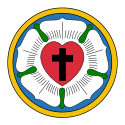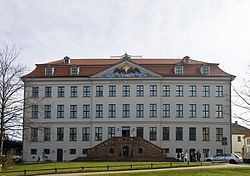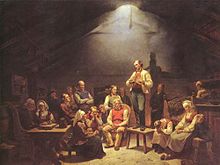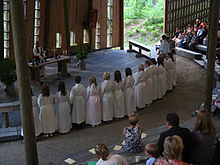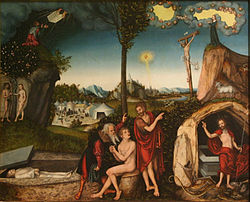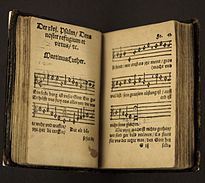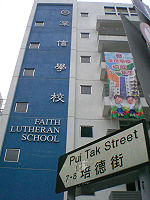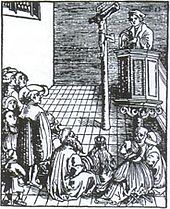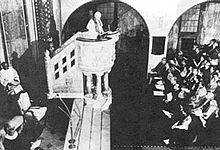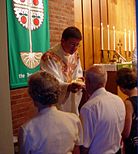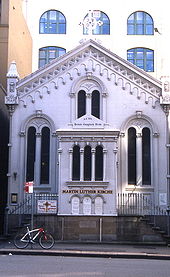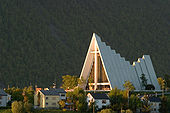- Lutheranism
-
Lutheranism is a major branch of Western Christianity that identifies with the theology of Martin Luther, a German reformer. Luther's efforts to reform the theology and practice of the church launched the Protestant Reformation. Beginning with the 95 Theses, Luther's writings disseminated internationally, spreading the ideas of the Reformation beyond the ability of governmental and churchly authorities to control it.[1]
The name "Lutheran" originated as a derogatory term used against Luther by Johann Eck during the Leipzig Debate in July 1519.[2] Eck and other Roman Catholics followed the traditional practice of naming a heresy after its leader, thus labeling all who identified with the theology of Martin Luther as Lutherans.[3] Martin Luther always disliked the term, preferring instead to describe the reform movement with the term "Evangelical", which was derived from euangelion, a Greek word meaning "good news", i.e. "Gospel."[2] Lutherans themselves began to use the term in the middle of the 16th century in order to identify themselves from other groups, such as Philippists and Calvinists. In 1597, theologians in Wittenberg used the title "Lutheran" to describe their church.[3]
The split between the Lutherans and the Roman Catholics began with the Edict of Worms in 1521, which officially excommunicated Luther and all of his followers.[3] The divide centered over the doctrine of Justification. Lutheranism advocates a doctrine of justification "by grace alone through faith alone because of Christ alone" which went against the Roman view of "faith formed by love", or "faith and works". Unlike the Reformed Churches, Lutherans retain many of the liturgical practices and sacramental teachings of the pre-Reformation Church. Lutheran theology significantly differs from Reformed theology in Christology, the purpose of God's Law, divine grace, the concept of perseverance of the saints, and predestination.
Contents
- 1 History
- 2 Doctrine
- 3 Practices
- 4 Throughout the world
- 5 Lutheran bodies
- 6 Notes
- 7 Further reading
- 8 External links
History
Lutheranism has its roots in the efforts of Martin Luther who sought to reform the Western Church to a more biblical foundation.[4][5][6][7]
Lutheranism spread through all of Scandinavia during the 16th century, as the monarch of Denmark-Norway (also ruling Iceland) and the monarch of Sweden (also ruling Finland) adopted Lutheranism.
Since 1520, regular[8] Lutheran services have been held in Copenhagen. Under the reign of Frederick I (1523–33), Denmark-Norway remained officially Catholic. Although Frederick initially pledged to persecute Lutherans, he soon adopted a policy of protecting Lutheran preachers and reformers, the most significant being Hans Tausen.[9]
During his reign, Lutheranism made significant inroads among the Danish population. At an open meeting in Copenhagen attended by the king in 1536, the people shouted; "We will stand by the holy Gospel, and do not want such bishops anymore".[10] Frederick's son Christian was openly Lutheran, which prevented his election to the throne upon his father's death. However, following his victory in the civil war that followed, in 1537 he became Christian III and advanced the Reformation in Denmark-Norway.
 Title page of the Swedish Gustav Vasa Bible, translated by the Petri brothers, along with Laurentius Andreae
Title page of the Swedish Gustav Vasa Bible, translated by the Petri brothers, along with Laurentius Andreae
The constitution upon which the Danish Norwegian Church, according to the Church Ordinance should rest was "The pure word of God, which is the Law and the Gospel".[11] It does not even mention the[12] Augsburg Confession. The priests at least had to[13] understand the Holy Script well enough to preach and explain the Gospel and the Epistles for their congregations.
The youths were taught[14] from the Small Catechism, available in Danish since 1532. They may in the end expect:[15] "forgiving of their sins", "to be counted as just", and "the eternal life". Instruction is still similar.[16] The first Bible in Danish was Martin Luther's. It was translated by 1550 and made available in 3000 copies.[17] It was sold out 30 years later. Important differences from today's Roman Catholicism are the Lutherans' refutation of the ideas that tradition is a carrier of the "Word of God", and that only the communion of the Bishop of Rome had been entrusted to interpret the "Word of God".[18][19]
The Reformation in Sweden began with Olaus and Laurentius Petri, brothers who took the Reformation to Sweden after studying in Germany. They led Gustav Vasa, elected king in 1523, to Lutheranism. The pope's refusal to allow the replacement of an archbishop that supported the invading forces opposing Gustav Vasa during the Stockholm Bloodbath led to the discontinuance of any official connection between Sweden and the papacy in 1523.[9]
Four years later, at the Diet of Västerås, the king succeeded in forcing the diet to accept his dominion over the national church. The king was given possession of all church properties such as the church appointments and the clergy. While this effectively granted official sanction to Lutheran ideas,[9] Lutheranism did not become official until 1593, when the Uppsala Synod declared Holy Scripture the sole guideline for faith, with four documents accepted as faithful and authoritative explanations of it: the Apostles' Creed, the Nicene Creed, the Athanasian Creed, and the unaltered Augsburg Confession of 1530.[20] Mikael Agricola's translation of the first Finnish New Testament was published in 1548.[21]
Schmalkaldic War and the Formula of Concord
 The University of Jena around 1600. Jena was the center of Gnesio-Lutheran activity during the controversies leading up to the Formula of Concord.
The University of Jena around 1600. Jena was the center of Gnesio-Lutheran activity during the controversies leading up to the Formula of Concord.
After the death of Luther in 1546, the Schmalkaldic War started out as a conflict between two German Lutheran rulers in 1547. Soon, Holy Roman Imperial forces joined the battle and conquered the members of the Schmalkaldic League, oppressing and exiling many German Lutherans as they enforced the terms of the Augsburg Interim. Religious freedom was secured for Lutherans through the Peace of Passau in 1552 and under the Cuius regio, eius religio and Declaratio Ferdinandei clauses of the Peace of Augsburg in 1555.[22]
Religious disputes between the Crypto-Calvinists, Philippists, Sacramentarians, Ubiquitarians, and Gnesio-Lutherans raged within Lutheranism during the middle of the 16th century. This finally ended with the resolution of the issues in the Formula of Concord. Large numbers of politically and religiously influential leaders met together, debated, and resolved these topics on the basis of Scripture, resulting in the Formula, which over 8,000 leaders signed. The Book of Concord replaced earlier, incomplete collections of doctrine, unifying all German Lutherans with identical doctrine and beginning the period of Lutheran Orthodoxy.
Lutheran orthodoxy
The historical period of Lutheran Orthodoxy is divided into three sections: Early Orthodoxy (1580–1600), High Orthodoxy (1600–1685), and Late Orthodoxy (1685–1730). Lutheran scholasticism developed gradually especially for the purpose of arguing with the Jesuits, and it was finally established by Johann Gerhard. Abraham Calovius represents the climax of the scholastic paradigm in orthodox Lutheranism. Other orthodox Lutheran theologians include Martin Chemnitz, Aegidius Hunnius, Leonhard Hutter, Nicolaus Hunnius, Jesper Rasmussen Brochmand, Salomo Glassius, Johann Hülsemann, Johann Conrad Dannhauer, Johannes Andreas Quenstedt, Johann Friedrich König, and Johann Wilhelm Baier.
Near the end of the Thirty Years' War, the compromising spirit seen in Philip Melanchthon rose up again in Helmstedt School and especially in theology of Georgius Calixtus, causing the Syncretistic Controversy. Another theological issue that arose was the Crypto-Kenotic Controversy.[23]
Late orthodoxy was torn by influences from rationalism, philosophy based on reason, and Pietism, a revival movement in Lutheranism. After a century of vitality, the Pietist theologians Philipp Jakob Spener and August Hermann Francke warned that orthodoxy had degenerated into meaningless intellectualism and Formalism, while orthodox theologians found the emotional and subjective focuses of Pietism to be vulnerable to Rationalist propaganda.[24]
The last famous orthodox Lutheran theologian before the rationalist Aufklärung, or Enlightenment, was David Hollatz. Late orthodox theologian Valentin Ernst Löscher took part in the controversy against Pietism. Medieval mystical traditions continued in works of Martin Moller, Johann Arndt, and Joachim Lütkemann. Pietism became a rival of orthodoxy but adopted some orthodox devotional literature; for example, Arndt's, Scriver's and Prätorius' which were combined Pietistic literature.
Rationalism
Rationalist philosophers from France and England had an enormous impact during the 18th century, along with the German Rationalists Christian Wolff, Gottfried Leibniz, and Immanuel Kant. Their work led to an increase in rationalist beliefs, at the expense of faith in God and agreement with the Bible.[24]
In 1709, Valentin Ernst Löscher warned that this new Rationalist view of the world fundamentally changed society by drawing into question every aspect of theology. Instead of considering the authority of divine revelation, he explained, Rationalists relied solely on their personal understanding when searching for truth.[25]
Johann Melchior Goeze (1717–1786), pastor of St. Catherine's Church, Hamburg, wrote apologetical works against Rationalists, including a theological and historical defence against the historical criticism of the Bible.[26]
Dissenting Lutheran pastors were often reprimanded by the government bureaucracy overseeing them, for example, when they tried to correct Rationalist influences in the parish school.[27] As a result of the impact of a local form of rationalism, termed Neology, by the latter half of the 18th century, genuine piety was found almost solely in small Pietist conventicles.[24] However, some of the laity preserved Lutheran orthodoxy from both Pietism and rationalism through reusing old catechisms, hymnbooks, postils, and devotional writings, including those written by Johann Gerhard, Heinrich Müller, and Christian Scriver.[28]
Revivals
A layman, Luther scholar Johann Georg Hamann (1730–88), became famous for countering Rationalism and striving to advance a revival known as the Erweckung, or Awakening.[29] In 1806, Napoleon's invasion of Germany promoted Rationalism and angered German Lutherans, stirring up a desire among the people to preserve Luther's theology from the Rationalist threat. Those associated with this Awakening held that reason was insufficient and pointed out the importance of emotional religious experience.[30][31]
Small groups sprang up, often in universities, which devoted themselves to Bible study, reading devotional writings, and revival meetings. Although the beginning of this Awakening tended heavily toward Romanticism, patriotism, and experience, the emphasis of the Awakening shifted around 1830 to restoring the traditional liturgy, doctrine, and confessions of the Lutheran church in the Neo-Lutheran movement.[32][33]
This Awakening swept through all of Scandinavia except for Iceland.[34] It developed from both German Neo-Lutheranism and Pietism. Danish pastor and philosopher Nikolaj Frederik Severin Grundtvig reshaped church life throughout Denmark through a reform movement beginning in 1830. He also wrote about 1,500 hymns, including God's Word Is Our Great Heritage.[35]
In Norway, Hans Nielsen Hauge, a lay street preacher, emphasized spiritual discipline and sparked the Haugean movement.[36] In Norway, the Awakening drove the growth of foreign missions to non-Christians to a new height, which has never been reached since.[34] In Sweden, Lars Levi Læstadius began the Laestadian movement that emphasized moral reform.[36] In Finland, a farmer, Paavo Ruotsalainen, began the Finnish Awakening when he took to preaching about repentance and prayer.[36]
In 1817, Frederick William III of Prussia ordered the Lutheran and Reformed churches in his territory to unite, forming the Evangelical Church of the Prussian Union. The unification of the two branches of German Protestantism sparked the Schism of the Old Lutherans. Many Lutherans, called "Old Lutherans", chose to leave the state churches despite imprisonment and military force.[29] Some formed independent church bodies, or "free churches", at home while others left for the United States and Australia. A similar legislated merger in Silesia prompted thousands to join the Old Lutheran movement. The dispute over ecumenism overshadowed other controversies within German Lutheranism.[37]
Despite political meddling in church life, local and national leaders sought to restore and renew Christianity. Neo-Lutheran Johann Konrad Wilhelm Löhe and Old Lutheran free church leader Friedrich August Brünn[38] both sent young men overseas to serve as pastors to German Americans, while the Inner Mission focused on renewing the situation home.[39] Johann Gottfried Herder, superintendent at Weimar and part of the Inner Mission movement, joined with the Romantic movement with his quest to preserve human emotion and experience from Rationalism.[40]
Ernst Wilhelm Hengstenberg, though raised Reformed, became convinced of the truth of historic Lutheranism as a young man.[41] He led the Neo-Lutheran Repristination School of theology, which advocated a return to the orthodox theologians of the 17th century and opposed modern Bible scholarship.[42] As editor of the periodical Evangelische Kirchenzeitung, he developed it into a major support of Neo-Lutheran revival and used it to attack all forms of theological liberalism and rationalism. Although he received a large amount of slander and ridicule during his forty years at the head of revival, he never gave up his positions.[41]
The theological faculty at the University of Erlangen in Bavaria became another force for reform.[41] There, professor Adolf von Harless, though previously an adherent of rationalism and German idealism, made Erlangen a magnet for revival oriented theologians.[43] Termed the Erlangen School of theology, they developed a new version of the Incarnation,[43] which they felt emphasized the humanity of Jesus better than the ecumenical creeds.[44] As theologians, they used both modern historical critical and Hegelian philosophical methods instead of attempting to revive the orthodoxy of the 17th century.[45]
Friedrich Julius Stahl led the High Church Lutherans. Though raised a Jew, he was baptized as a Christian at the age of 19 through the influence of the Lutheran school he attended. As the leader of a neofeudal Prussian political party, he campaigned for the divine right of kings, the power of the nobility, and episcopal polity for the church. Along with Kliefoth and Vilmar, he promoted agreement with Roman Catholicism with regard to the authority of the institutional church, ex opere operato effectiveness of the sacraments, and the divine authority of clergy. Unlike Roman Catholics, however, they also urged complete agreement with the Book of Concord.[44]
The Neo-Lutheran movement managed to slow secularism and counter atheistic Marxism, but it did not fully succeed in Europe.[39] It partly succeeded in continuing the Pietist movement's drive to right social wrongs and focus on individual conversion. The Neo-Lutheran call to renewal failed to achieve widespread popular acceptance because it both began and continued with a lofty, idealistic Romanticism that did not connect with an increasingly industrialized and secularized Europe.[46] At best, the work of local leaders resulted in specific areas with vibrant spiritual renewal, but people in Lutheran areas overall continued to become increasingly distant from church life.[39] By 1969, Manfried Kober complained that “unbelief is rampant” even within German Lutheran parishes.[47]
Doctrine
The Bible
Traditionally, Lutherans hold the Bible of the Old and New Testaments to be the only divinely inspired book, the only source of divinely revealed knowledge, and the only norm for Christian teaching.[48] Scripture alone is the formal principle of the faith, the final authority for all matters of faith and morals because of its inspiration, authority, clarity, efficacy, and sufficiency.[49]
The authority of the Scriptures has been challenged during the history of Lutheranism. Martin Luther taught that the Bible was the written Word of God, and the only reliable guide for faith and practice. He held that every passage of Scripture has one straightforward meaning, the literal sense as interpreted by other Scripture.[50] These teachings were accepted during the orthodox Lutheranism of the 17th century.[51] During the 18th century, Rationalism advocated reason rather than the authority of the Bible as the final source of knowledge, but most of the laity did not accept this Rationalist position.[52] In the 19th century, a confessional revival reemphasized the authority of the Bible and agreement with the Lutheran Confessions.
Today, Lutherans disagree about the inspiration and authority of the Bible. Theological conservatives use the historical-grammatical method of Biblical interpretation, while theological liberals use the higher critical method. The 2008 U.S. Religious Landscape Survey conducted by the Pew Research Center surveyed 1,926 adults in the United States that self-identified as Lutheran. The study found that 30% believed that the Bible was the Word of God and was to be taken literally word for word. 40% held that the Bible was the Word of God, but was not literally true word for word or were unsure if it was literally true word for word. 23% said the Bible was written by men and not the Word of God. 7% did not know, were not sure, or had other positions.[53]
Inspiration
Although many Lutherans today hold less specific views of inspiration, historically, Lutherans affirm that the Bible does not merely contain the Word of God, but every word of it is, because of plenary, verbal inspiration, the direct, immediate word of God.[54] The Apology of the Augsburg Confession identifies Holy Scripture with the Word of God[55] and calls the Holy Spirit the author of the Bible.[56] Because of this, Lutherans confess in the Formula of Concord, "we receive and embrace with our whole heart the prophetic and apostolic Scriptures of the Old and New Testaments as the pure, clear fountain of Israel."[57] The apocryphal books were not written by the prophets, by inspiration; they contain errors[58] were never included in the Judean Canon that Jesus used,[59] and therefore are not a part of Holy Scripture.[60] The prophetic and apostolic Scriptures are authentic as written by the prophets and apostles. A correct translation of their writings is God's Word because it has the same meaning as the original Hebrew and Greek.[60] A mistranslation is not God's word, and no human authority can invest it with divine authority.[60]
Divine authority
Historically, Lutherans maintain that Holy Scripture, the Word of God, carries the full authority of God. For confessional Lutherans, every single statement of the Bible calls for instant and unqualified acceptance. For Lutherans that are more aligned with mainline Protestantism, a basic claim is made that the canonical Scriptures of the Old and New Testaments are the inspired Word of God and the authoritative source and norm of its proclamation, faith, and life. This allows for historical-critical methods for interpretation.
Clarity
Historically, Lutherans understand the Bible to present all doctrines and commands of the Christian faith clearly.[61] God's Word is freely accessible to every reader or hearer of ordinary intelligence, without requiring any special education.[62] Of course, one must understand the language God's Word is presented in, and not be so preoccupied by contrary thoughts so as to prevent understanding.[63] As a result of this, no one needs to wait for any clergy, pope, scholar, or ecumenical council to explain the real meaning of any part of the Bible.[64]
Efficacy
Lutherans confess that Scripture is united with the power of the Holy Spirit and with it, not only demands, but also creates the acceptance of its teaching.[65] This teaching produces faith and obedience. Holy Scripture is not a dead letter, but rather, the power of the Holy Spirit is inherent in it.[66] Scripture does not compel a mere intellectual assent to its doctrine, resting on logical argumentation, but rather it creates the living agreement of faith.[67] As the Smalcald Articles affirm, "in those things which concern the spoken, outward Word, we must firmly hold that God grants His Spirit or grace to no one, except through or with the preceding outward Word."[68]
Sufficiency
Lutherans are confident that the Bible contains everything that one needs to know in order to obtain salvation and to live a Christian life.[69] There are no deficiencies in Scripture that need to be filled with by tradition, pronouncements of the Pope, new revelations, or present-day development of doctrine.[70]
Law and Gospel


Title Page from the 1580 Dresden Book of Concord Lutherans understand the Bible as containing two distinct types of content, termed Law and Gospel (or Law and Promises).[71] Properly distinguishing between Law and Gospel prevents the obscuring of the Gospel teaching of justification by grace through faith alone.[72]
Lutheran Confessions
The Book of Concord, published in 1580, contains ten documents which some Lutherans believe are faithful and authoritative explanations of Holy Scripture. Besides the three Ecumenical Creeds, which date to Roman times, the Book of Concord contains seven credal documents articulating Lutheran theology in the Reformation era.
The doctrinal positions of Lutheran churches are not uniform because the Book of Concord does not hold the same position in all Lutheran churches. For example, the state churches in Scandinavia consider only the Augsburg Confession as a "summary of the faith" in addition to the three ecumenical Creeds.[73] Lutheran pastors, congregations, and church bodies in Germany and the Americas usually agree to teach in harmony with the entire Lutheran Confessions. Some Lutheran church bodies require this pledge to be unconditional because they believe the confessions correctly state what the Bible teaches. Others allow their congregations to do so "insofar as" the Confessions are in agreement with the Bible.
Justification
 Law and Grace, by Lucas Cranach. The left side shows humans' condemnation under God's law, while the right side presents God's grace in Christ.
Law and Grace, by Lucas Cranach. The left side shows humans' condemnation under God's law, while the right side presents God's grace in Christ.
The key doctrine, or material principle, of Lutheranism is the doctrine of justification. Lutherans believe that humans are saved from their sins by God's grace alone (Sola Gratia), through faith alone (Sola Fide). Lutherans believe that this grace is granted for the sake of Christ's merit alone (Solus Christus). Orthodox Lutheran theology holds that God made the world, including humanity, perfect, holy and sinless. However, Adam and Eve chose to disobey God, trusting in their own strength, knowledge, and wisdom.[74][75] Consequently, people are saddled with original sin, born sinful and unable to avoid committing sinful acts.[76] For Lutherans, original sin is the "chief sin, a root and fountainhead of all actual sins."[77]
Lutherans teach that sinners, while capable of doing works that are outwardly "good," are not capable of doing works that satisfy God's justice.[78] Every human thought and deed is infected with sin and sinful motives.[79] Because of this, all humanity deserves eternal damnation in hell.[80] God in eternity has turned His Fatherly heart to this world and planned for its redemption because he loves all people and does not want anyone to be eternally damned.[81]
To this end, "God sent his Son Jesus Christ, our Lord, into the world to redeem and deliver us from the power of the devil, and to bring us to Himself, and to govern us as a King of righteousness, life, and salvation against sin, death, and an evil conscience," as the Large Catechism explains.[82] Because of this, Lutherans teach that salvation is possible only because of the grace of God made manifest in the birth, life, suffering, death, and resurrection, and continuing presence by the power of the Holy Spirit, of Jesus Christ.[83] By God's grace, made known and effective in the person and work of Jesus Christ, a person is forgiven, adopted as a child and heir of God, and given eternal salvation.[84] Christ, because he was entirely obedient to the law with respect to both his human and divine natures, "is a perfect satisfaction and reconciliation of the human race," as the Formula of Concord asserts, and proceeds to summarize:[85]
[Christ] submitted to the law for us, bore our sin, and in going to his Father performed complete and perfect obedience for us poor sinners, from his holy birth to his death. Thereby he covered all our disobedience, which is embedded in our nature and in its thoughts, words, and deeds, so that this disobedience is not reckoned to us as condemnation but is pardoned and forgiven by sheer grace, because of Christ alone.
Lutherans believe that individuals receive this gift of salvation through faith alone.[86] Saving faith is the knowledge of,[87] acceptance of,[88] and trust[89] in the promise of the Gospel.[90] Even faith itself is seen as a gift of God, created in the hearts of Christians[91] by the work of the Holy Spirit through the Word[92] and Baptism.[93] Faith receives the gift of salvation rather than causes salvation.[94] Thus, Lutherans reject the "decision theology" which is common among modern evangelicals.
Trinity
Lutherans are Trinitarian; they confess in the Nicean Creed: the version in Evangelical Lutheran Worship (2006) of the Evangelical Lutheran Church in America (ELCA) and the Evangelical Lutheran Church in Canada (ELCIC) is the 1988 ecumenical (ELLC) version. But the Lutheran Service Book(2006) of the Lutheran Church–Missouri Synod (LCMS) and the Lutheran Church–Canada (LCC) is that of the 1662 Book of Common Prayer with modernized spelling of the words "catholic" and "apostolic", with changes in capitalization of these and other words, and with "Holy Spirit" in place of "Holy Ghost". Lutherans reject the idea that the Father and the Son are merely faces of the same person, stating that both the Old Testament and the New Testament show them to be two distinct persons.[95] Lutherans believe the Holy Spirit proceeds from both the Father and the Son.[96] "We worship one God in Trinity, and Trinity in Unity; Neither confounding the Persons, nor dividing the Substance. For there is one Person of the Father, another of the Son, and another of the Holy Ghost. But the Godhead of the Father, of the Son, and of the Holy Ghost is all one: the glory equal, the majesty coeternal."
Two natures of Christ
Lutherans believe Jesus is the Christ, the savior promised in the Old Testament. They believe he is both by nature God and by nature man in one person, as they confess in Luther's Small Catechism that he is "true God begotten of the Father from eternity and also true man born of the Virgin Mary".[97]
The Augsburg Confession explains:[98]
[T]he Son of God, did assume the human nature in the womb of the blessed Virgin Mary, so that there are two natures, the divine and the human, inseparably enjoined in one Person, one Christ, true God and true man, who was born of the Virgin Mary, truly suffered, was crucified, dead, and buried, that He might reconcile the Father unto us, and be a sacrifice, not only for original guilt, but also for all actual sins of men.
Sacraments
Main article: Lutheran sacramentsLutherans hold that sacraments are sacred acts of divine institution.[99] Whenever they are properly administered by the use of the physical component commanded by God[100] along with the divine words of institution,[101] God is, in a way specific to each sacrament, present with the Word and physical component.[102] He earnestly offers to all who receive the sacrament[103] forgiveness of sins[104] and eternal salvation.[105] He also works in the recipients to get them to accept these blessings and to increase the assurance of their possession.[106]
Lutherans are not dogmatic about the number of the sacraments.[108] In line with Luther's initial statement in his Large Catechism some speak of only two sacraments,[109] Baptism and Holy Communion, although later in the same work he calls Confession and Absolution[110] "the third sacrament."[111] The definition of sacrament in the Apology of the Augsburg Confession lists Absolution as one of them.[112] Since Absolution is a return to the forgiveness given in baptism, strictly speaking there are only two sacraments. Confession is not practiced among Lutherans as often as in the Roman Church. Rather, it is expected before receiving the Eucharist for the first time.[113] Some churches also allow for individual absolution on Saturdays before the Eucharistic service. A general absolution (known as the Penitential Rite) is proclaimed in the Eucharistic liturgy. Lutherans do not emphasize "penance" as a retribution of sin but rather the proclamation of God's forgiveness by the "called and ordained" minister of the Holy Gospel.
Baptism
Lutherans hold that Baptism is a saving work of God,[114] mandated and instituted by Jesus Christ.[115] Baptism is a "means of grace" through which God creates and strengthens "saving faith" as the "washing of regeneration"[116] in which infants and adults are reborn.[117] Since the creation of faith is exclusively God's work, it does not depend on the actions of the one baptized, whether infant or adult. Even though baptized infants cannot articulate that faith, Lutherans believe that it is present all the same.[118]
Because it is faith alone that receives these divine gifts, Lutherans confess that baptism "works forgiveness of sins, delivers from death and the devil, and gives eternal salvation to all who believe this, as the words and promises of God declare."[119] Holding fast to the Scripture cited in 1 Peter 3:21 "and this water symbolizes baptism that now saves you also—not the removal of dirt from the body but the pledge of a good conscience toward God. It saves you by the resurrection of Jesus Christ." Therefore, Lutherans administer Baptism to both infants[120] and adults.[121] In the special section on infant baptism in his Large Catechism, Luther argues that infant baptism is God-pleasing because persons so baptized were reborn and sanctified by the Holy Spirit.[122][123]
Eucharist
Main article: Eucharist in the Lutheran ChurchLutherans hold that within the Eucharist, also referred to as the Sacrament of the Altar, the Mass, or the Lord's Supper, the true body and blood of Christ are truly present "in, with, and under the forms" of the consecrated bread and wine for all those who eat and drink it,[124] a doctrine that the Formula of Concord calls the sacramental union.[125]
Conversion
In Lutheranism, conversion or regeneration in the strict sense of the term is the work of divine grace and power by which man, born of the flesh, and void of all power to think, to will, or to do any good thing, and dead in sin is, through the gospel and holy baptism, taken from a state of sin and spiritual death under God's wrath into a state of spiritual life of faith and grace, rendered able to will and to do what is spiritually good and, especially, made to trust in the benefits of the redemption which is in Christ Jesus.[126]
During conversion, one is moved from impenitence to repentance. The Augsburg Confession divides repentance into two parts: "One is contrition, that is, terrors smiting the conscience through the knowledge of sin; the other is faith, which is born of the Gospel, or of absolution, and believes that for Christ's sake, sins are forgiven, comforts the conscience, and delivers it from terrors."[127]
Predestination
Lutherans adhere to divine monergism, the teaching that salvation is by God's act alone, and therefore reject the idea that humans in their fallen state have a free will concerning spiritual matters.[129] Lutherans believe that although humans have free will concerning civil righteousness, they cannot work spiritual righteousness in the heart without the presence and aid of the Holy Spirit.[130][131] Lutherans believe Christians are "saved";[132] that all who trust in Christ alone and his promises can be certain of their salvation.[133]
According to Lutheranism, the central final hope of the Christian is "the resurrection of the body and the life everlasting" as confessed in the Apostles' Creed rather than predestination. Lutherans disagree with those who make predestination - rather than Christ's suffering, death, and resurrection - the source of salvation. Unlike Calvinists, Lutherans do not believe in a predestination to damnation,[134] usually referencing "God our Savior, who desires all people to be saved and to come to the knowledge of the truth" [135] as contrary evidence to such a claim. Instead, Lutherans teach eternal damnation is a result of the unbeliever's sins, rejection of the forgiveness of sins, and unbelief.[136]
Divine providence
According to Lutherans, God preserves his creation, cooperates with everything that happens, and guides the universe.[137] While God cooperates with both good and evil deeds, with evil deeds he does so only inasmuch as they are deeds, but not with the evil in them. God concurs with an act's effect, but he does not cooperate in the corruption of an act or the evil of its effect.[138] Lutherans believe everything exists for the sake of the Christian Church, and that God guides everything for its welfare and growth.[139]
The explanation of the Apostles' Creed given in the Small Catechism declares that everything good that people have is given and preserved by God, either directly or through other people or things.[140] Of the services others provide us through family, government, and work, "we receive these blessings not from them, but, through them, from God."[141] Since God uses everyone's useful tasks for good, people should look not down upon some useful vocations as being less worthy than others. Instead people should honor others, no matter how lowly, as being the means God uses to work in the world.[141]
Good works
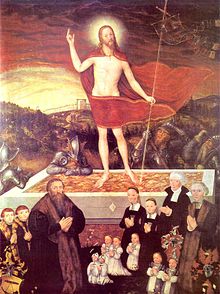 "Even though I am a sinner and deserving of death and hell, this shall nonetheless be my consolation and my victory that my Lord Jesus lives and has risen so that He, in the end, might rescue me from sin, death, and hell."—Luther[142]
"Even though I am a sinner and deserving of death and hell, this shall nonetheless be my consolation and my victory that my Lord Jesus lives and has risen so that He, in the end, might rescue me from sin, death, and hell."—Luther[142]
Lutherans believe that good works are the fruit of faith,[143] always and in every instance.[144] Good works have their origin in God,[145] not in the fallen human heart or in human striving;[146] their absence would demonstrate that faith, too, is absent.[147] Lutherans do not believe that good works are a factor in obtaining salvation; they believe that we are saved by the grace of God - based on the merit of Christ in his suffering and death - and faith in the triune god. Good works are the natural result of faith, not the cause of salvation. Although Christians are no longer compelled to keep God's law, they freely and willingly serve God and their neighbors.[148]
Judgment and eternal life
Lutherans do not believe in any sort of earthly millennial kingdom of Christ either before or after his second coming on the last day.[149] Lutherans teach that, at death, the souls of Christians are immediately taken into the presence of Jesus,[150] where they await the second coming of Jesus on the last day.[151] On the last day,[152] all the bodies of the dead will be resurrected.[153]
Their souls will then be reunited with the same bodies they had before dying.[154] The bodies will then be changed, those of the wicked to a state of everlasting shame and torment,[155] those of the righteous to an everlasting state of celestial glory.[156] After the resurrection of all the dead,[157] and the change of those still living,[158] all nations shall be gathered before Christ,[159] and he will separate the righteous from the wicked.[160]
Christ will publicly judge[161] all people by the testimony of their deeds,[162] the good works[163] of the righteous in evidence of their faith,[164] and the evil works of the wicked in evidence of their unbelief.[165] He will judge in righteousness[166] in the presence of all people and angels,[167] and his final judgment will be just damnation to everlasting punishment for the wicked and a gracious gift of life everlasting to the righteous.[168]
Comparison among Protestants
This table summarizes the classical views of three different Protestant beliefs about salvation.[169]
Topic Lutheranism Calvinism Arminianism Human will Total Depravity without free will until spiritual regeneration Total Depravity without free will permanently due to the nature of divine sovereignty Total depravity, with prevenient grace, does not preclude free will Election Unconditional election to salvation only Unconditional election to salvation and damnation (double-predestination) Conditional election on the basis of foreseen faith or unbelief Justification Justification of all people completed at Christ's death[citation needed] Justification is limited to those predestined to salvation, completed at Christ's death Justification made possible for all through Christ's death, but only completed upon placing faith in Jesus (hypothetical universalism) Conversion Monergistic, through the means of grace, resistible Monergistic, through the inner calling of the Holy Spirit, irresistible Synergistic, resistible due to the common, sufficient grace of free will Preservation and apostasy Falling away is possible, but reflection on one's faith provides assurance of preservation Perseverance of the saints: the eternally elect in Christ will necessarily persevere in faith and subsequent holiness until the end Preservation is conditional upon continued faith in Christ; reflection on one's faith provides assurance Practices
Liturgy
Lutherans place great emphasis on a liturgical approach to worship services;[170] although there are substantial non-liturgical minorities, for example, the Haugean Lutherans from Norway. Music forms a large part of Lutheran services. Lutheran hymns are sometimes known as chorales. Lutheran hymnody is well known for its doctrinal, didactic, and musical richness. Most Lutheran churches are active musically with choirs, handbell choirs, children's choirs, and occasionally carillon groups that ring bells in a bell tower. Johann Sebastian Bach, a devout Lutheran, composed music for the Lutheran church.
Lutherans also preserve a liturgical approach to the celebration of the Mass (or the Holy Eucharist/Communion), emphasizing the sacrament as the central act of Christian worship. Lutherans believe that the actual body and blood of Jesus Christ are present in, with and under the bread and the wine. This belief is called Real Presence or sacramental union and is different from consubstantiation and transubstantiation. Additionally Lutherans reject the idea that communion is a mere symbol or memorial. They confess in the Apology of the Augsburg Confession:
-
- "...we do not abolish the Mass but religiously keep and defend it. Among us the Mass is celebrated every Lord's Day and on other festivals, when the Sacrament is made available to those who wish to partake of it, after they have been examined and absolved. We also keep traditional liturgical forms, such as the order of readings, prayers, vestments, and other similar things." (Apology of the Augsburg Confession, Article XXIV.1)
Besides the Holy Communion (Divine Service), congregations also hold offices, which are worship services without communion. They may include Matins, Vespers, Compline, and Easter Vigil. Private or family offices include the Morning and Evening Prayers from Luther's Small Catechism.[171] Meals are blessed with the Common Table Prayer, Psalm 145:15–16, or other prayers, and after eating the Lord is thanked, for example, with Psalm 136:1.[171] In addition, Lutherans use devotional books, from small daily devotionals, for example, Portals of Prayer, to large breviaries, including the Breviarium Lipsiensae and Treasury of Daily Prayer.
In the 1970s, many Lutheran churches began holding contemporary worship services for the purpose of evangelistic outreach. These services were in a variety of styles, depending on the preferences of the congregation. Often they were held alongside a traditional service in order to cater to those who preferred contemporary worship music. Today, few but some Lutheran congregations have contemporary worship as their sole form of worship. Outreach is no longer given as the primary motivation; rather this form of worship is seen as more in keeping with the desires of individual congregations.[172] In Finland, Lutherans have experimented with the St Thomas Mass or Metal Mass in which traditional hymns are adapted to heavy metal. The Lutheran World Federation, in its Nairobi Statement on Worship and Culture, recommended every effort be made to bring church services into a more sensitive position with regard to cultural context.[173]
Lutheran churches use hymnals as well as electronic projection media. In 2006, both the Evangelical Lutheran Church in America and the Lutheran Church – Missouri Synod, in cooperation with certain foreign English speaking church bodies within their respective fellowships, released new hymnals: Evangelical Lutheran Worship (ELCA) and Lutheran Service Book (LCMS). Along with these, the most widely used among English speaking congregations include: Evangelical Lutheran Hymnary (1996, ELS), The Lutheran Book of Worship (1978, LC-USA), Lutheran Worship (1982, LCMS), Christian Worship (1993, WELS), and The Lutheran Hymnal (1941, Synodical Conference). In the Lutheran Church of Australia, the official hymnal is the Lutheran Hymnal with Supplement of 1986, which includes a supplement to the Lutheran Hymnal of 1973, itself a replacement for the Australian Lutheran Hymn Book of 1921. Prior to this time, the two Lutheran church bodies in Australia (which merged in 1966) used a bewildering variety of hymnals, usually in the German language.
Missions
Sizable Lutheran missions arose for the first time during the 19th century. Early missionary attempts during the century after the Reformation did not succeed. However, European traders brought Lutheranism to Africa beginning in the 17th century as they settled along the coasts. During the first half of the 19th century, missionary activity in Africa expanded, including preaching by missionaries, translation of the Bible, and education.[174]
Lutheranism came to India beginning with the work of Bartholomäus Ziegenbalg, where a community totaling several thousand developed, complete with their own translation of the Bible, catechism, their own hymnal, and system of Lutheran schools. In the 1840s, this church experienced a revival through the work of the Leipzig Mission, including Karl Graul.[175] After German missionaries were expelled in 1914, Lutherans in India became entirely autonomous, yet preserved their Lutheran character. In recent years India has relaxed its anti-religious conversion laws, allowing a resurgence in missionary work.
In Latin America, missions began to serve European immigrants of Lutheran background, both those who spoke German and those who no longer did. These churches in turn began to evangelize those in their areas who were not of European background, including indigenous peoples.[176]
In 1892, the first Lutheran missionaries reached Japan. Although work began slowly and a major setback occurred during the hardships of WWII.[177] Lutheranism there has survived and become self-sustaining.[178] After missionaries to China, including those of the Lutheran Church of China, were expelled, they began ministry in Taiwan and Hong Kong, the latter which became a center of Lutheranism in Asia.[178]
The Lutheran Mission in New Guinea, though founded only in 1953, became the largest Lutheran mission in the world in only several decades. Through the work of native lay evangelists, many tribes of diverse languages were reached with the Gospel.[178]
Education
Catechism is considered basic in most Lutheran churches. Almost all maintain Sunday Schools, and some host or maintain Lutheran schools, at the preschool, elementary, middle, high school, folk high school, or university level. Life-long study of the catechism is intended for all ages so that the abuses of the pre-Reformation Church will not recur.[179] Lutheran schools have always been a core aspect of Lutheran mission work, starting with Bartholomew Ziegenbalg and Heinrich Putschasu, who began work in India in 1706.[3]
Pastors almost always have substantial theological educations, including Greek and Hebrew so that they can refer to the Christian scriptures in the original language. Pastors usually teach in the common language of the local congregation. In the U.S., some congregations and synods historically taught in German, Danish, Finnish, Norwegian, or Swedish, but retention of immigrant languages has been in significant decline since the early and middle 20th century.
Lutherans have a heritage of not only learned theologians, but also theologically adept laypeople. Among the laity there is an emphasis on life-long study of the Bible, Luther's Small Catechism, and other theological works.
Church fellowship
Lutherans were divided about the issue of church fellowship for the first thirty years after Luther's death. Philipp Melanchthon and his Philippist party felt that Christians of different beliefs should join in union with each other without completely agreeing on doctrine. Against them stood the Gnesio-Lutherans, led by Matthias Flacius and the faculty at Jena. They condemned the Philippist position for indifferentism, describing it as a "unionistic compromise" of precious Reformation theology. Instead, they held that genuine unity between Christians and real theological peace was only possible with an honest agreement about every subject of doctrinal controversy.[180]
Complete agreement finally came about in 1577, after the death of both Melanchthon and Flacius, when a new generation of theologians resolved the doctrinal controversies on the basis of Scripture in the Formula of Concord of 1577.[181] Although they decried the visible division of Christians on earth, orthodox Lutherans avoided ecumenical fellowship with other churches, believing that Christians should not, for example, join together for the Lord's Supper or exchange pastors if they do not completely agree about what the Bible teaches. In the 17th century, Georgius Calixtus began a rebellion against this practice, sparking the Syncretistic Controversy with Abraham Calovius as his main opponent.[182]
In the 18th century, there was some ecumenical interest between the Church of Sweden and the Church of England. John Robinson, Bishop of London, planned for a union of the English and Swedish churches in 1718. The plan failed because most Swedish bishops rejected the Calvinism of the Church of England, although Swedberg and Gezelius, bishops of Skara, Sweden and Turku, Finland, were in favor.[183] With the encouragement of Swedberg, church fellowship was established between Swedish Lutherans and Anglicans in the Middle Colonies. Over the course of the 1700s and the early 1800s, Swedish Lutherans were absorbed into Anglican churches, with the last original Swedish congregation completing merger into the Episcopalians in 1846.[184]
In the 19th century, Samuel Simon Schmucker attempted to lead the Evangelical Lutheran General Synod of the United States toward unification with other American Protestants. His attempt to get the synod to reject the Augsburg Confession in favor of his compromising Definite Platform failed. Instead, it sparked a Neo-Lutheran revival, prompting many to form the General Council, including Charles Porterfield Krauth. Their alternative approach was “Lutheran pulpits are for Lutheran ministers only, and Lutheran altars are for Lutheran communicants only.”
.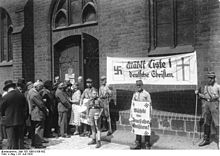 Stormtroopers holding German Christians propaganda during the Church Council elections on July 23, 1933 at St. Mary's Church, Berlin. These elections resulted in the merger of the German state churches.
Stormtroopers holding German Christians propaganda during the Church Council elections on July 23, 1933 at St. Mary's Church, Berlin. These elections resulted in the merger of the German state churches.
Beginning in 1867, confessional and liberal minded Lutherans in Germany joined together to form the Common Evangelical Lutheran Conference against the ever looming prospect of a state-mandated union with the Reformed.[185] However, they failed to reach a consensus among themselves on how much agreement in doctrine is necessary for church union.[39] Eventually, the fascist German Christians movement pushed the final national merger of Lutheran, Union, and Reformed churches into a single Reich Church, now the Evangelical Church in Germany, in 1933.
Presently, Lutherans are divided over how to interact with other Christian denominations. Some Lutherans assert that everyone must share the "whole counsel of God" (Acts 20:27) in complete unity (1 Cor. 1:10)[186] before pastors can share each others' pulpits, and before communicants commune at each others' altars, a practice termed closed (or close) communion. On the other hand, other Lutherans are practice varying degrees of open communion and allow preachers from other Christian denominations in their pulpits.
While not an issue in the majority of Lutheran church bodies, some of them forbid membership in Freemasonry. Partly, this is because the lodge is viewed as spreading Unitarianism, as the Brief Statement of the Missouri Synod reads, "Hence we warn against Unitarianism, which in our country has to a great extent impenetrated the sects and is being spread particularly also through the influence of the lodges."[187] A 1958 report from the publishing house of the Wisconsin Evangelical Lutheran Synod states that, "Masonry is guilty of idolatry. Its worship and prayers are idol worship. The Masons may not with their hands have made an idol out of gold, silver, wood or stone, but they created one with their own mind and reason out of purely human thoughts and ideas. The latter is an idol no less than the former."[188]
The largest organizations of Lutheran churches around the world are the Lutheran World Federation, the International Lutheran Council, and the Confessional Evangelical Lutheran Conference. These organizations together include the great majority of Lutheran denominations around the globe. The Lutheran World Federation supports the activities of Lutheran World Relief, a relief and development agency active in more than 50 countries. The LCMS and the LCC are members of the International Lutheran Council (ILC). The WELS and ELS are members of the Confessional Evangelical Lutheran Conference. Many Lutheran churches are not affiliated with the LWF, the ILC or the CELC: The congregations of the Church of the Lutheran Confession (CLC) are affiliated with their mission organizations in Canada, India, Nepal, Myanmar, and many African nations; and those affiliated with the Church of the Lutheran Brethren, are especially active doing mission work in Africa and East Asia.
The Lutheran World Federation (LWF)-aligned churches do not believe that one church is singularly true in its teachings. According to this belief, Lutheranism is a reform movement rather than a movement into doctrinal correctness. For that reason, a number of doctrinally diverse LWF denominations, now largely separated from state control, are declaring fellowship and joint statements of agreement with other Lutheran and non-Lutheran Christian denominations.
The Lutheran World Federation and the Missouri Synod engaged in a series of official dialogues with the Roman Catholic Church since shortly after the Second Vatican Council. In 1999 the LWF and the Roman Catholic Church jointly issued a statement, the Joint Declaration on the Doctrine of Justification (JDDJ), that stated that the LWF and the Roman Catholic both agreed about certain basics of Justification and lifted certain Roman Catholic anathemas formerly applying to the LWF member churches. The Missouri Synod has participated in most of these talks, though not the one which produced the Joint Declaration and to which they were not invited. While some Lutheran theologians saw the Joint Declaration as a sign that the Roman Catholics were essentially adopting the Lutheran position, other Lutheran theologians disagreed, claiming that, considering the public documentation of the Roman Catholic position, this assertion does not hold up.
By contrast, the Confessional Evangelical Lutheran Conference and International Lutheran Council as well as some unaffiliated denominations such as the Church of the Lutheran Confession (CLC) maintain that the orthodox confessional Lutheran churches are the only churches with completely correct doctrine. They teach that while other Christian churches teach partially orthodox doctrine and have true Christians as members, the doctrines of those churches contain significant errors. More conservative Lutherans strive to maintain historical distinctiveness while emphasizing doctrinal purity alongside Gospel-motivated outreach. They claim that LWF Lutherans are practicing "fake ecumenism" by desiring church fellowship outside of actual unity of teaching.[189]
Although not an "ecumenical" movement in the formal sense, in the 1990s influences from the megachurches of American evangelicalism have become somewhat common. Many of the largest Lutheran congregations in the United States have been heavily influenced by these "progressive Evangelicals." These influences are sharply criticized by some Lutherans as being foreign to orthodox Lutheran beliefs.[190]
The Porvoo Communion is a communion of episcopally led Lutheran and Anglican churches in Europe. Beside its membership in the Porvoo Communion, Church of Sweden also has declared full communion with the Philippine Independent Church and the United Methodist Church.
The Evangelical Lutheran Church in America (ELCA) has been involved in ecumenical dialogues with several denominations. Recently, the ELCA has declared full communion with several American Churches: the Moravian Church, the Episcopal Church, the Presbyterian Church (U.S.A.), the Reformed Church in America, the United Methodist Church, and the United Church of Christ.
Throughout the world
Today, millions belong to Lutheran communities, which are present on all populated continents.[191] Lutheranism is the largest religious group in Denmark, the Faroe Islands, Greenland, Iceland, Norway, Sweden, Finland, Estonia, Latvia, Namibia, and the Dakotas. Lutheranism is also the dominant form of Christianity in the White Mountain and San Carlos Apache nations. In addition, Lutheranism is a main Protestant denomination in Germany (where it forms about half the country's Christian population), Lithuania, Poland, Austria, Slovakia, Slovenia, Croatia, Serbia, Kazakhstan, Tajikistan, Papua New Guinea, North Sumatra Indonesia, and Tanzania.[192]
Although Namibia is the only country outside Europe to have a Lutheran majority, there are sizable Lutheran bodies in other African countries. In addition, the following nations also have sizable Lutheran populations: Australia, Brazil, Canada, Ethiopia, India, Indonesia, Madagascar, and the United States, especially in the heavily German and Scandinavian Upper Midwest.[193]
Lutheran bodies
- List of Lutheran denominations
- Lutheran church bodies in North America
- List of Lutheran clergy
- List of Lutheran colleges and universities
- List of Lutheran dioceses and archdioceses
- List of Lutheran schools in Australia
Notes
- ^ MSN Encarta, s.v. "Lutheranism" by George Wolfgang Forell; Christian Cyclopedia, s.v. "Reformation, Lutheran" by Lueker, E. et. al. Archived 2009-10-31.
- ^ a b Espín, Orlando O. and Nickoloff, James B. An introductory dictionary of theology and religious studies. Collegeville, Minnesota: Liturgical Press, p. 796.
- ^ a b c d Fahlbusch, Erwin, and Bromiley, Geoffrey William, The Encyclopedia of Christianity, Volume 3. Grand Rapids, Michigan: Eerdmans, 2003. p.362.
- ^ How Lutherans Got Started
- ^ Lutherans, Biblehistory.com
- ^ Martin Luther Biography – Martin Luther Childhood, Life & Timeline
- ^ Reformation: Martin Luther
- ^ Historisk fremstilling af reformationens indførelse i Danmark, p. 64
- ^ a b c Chapter 12 The Reformation In Germany And Scandinavia, Renaissance and Reformation by William Gilbert.
- ^ Historisk fremstilling af reformationens indførelse i Danmark, p. 195
- ^ Historisk fremstilling af reformationens indførelse i Danmark, p. 202
- ^ Historisk fremstilling af reformationens indførelse i Danmark, p. 207
- ^ Historisk fremstilling af reformationens indførelse i Danmark, p. 70
- ^ Historisk fremstilling af reformationens indførelse i Danmark, p. 210
- ^ Historisk fremstilling af reformationens indførelse i Danmark, p. 205
- ^ (line 33–34)
- ^ A Dictionary Of The Bible, p. 416
- ^ § 13 and 16
- ^ Historisk fremstilling af reformationens indførelse i Danmark, p. 25
- ^ N.F. Lutheran Cyclopedia, article, "Upsala, Diet of", New York: Schrivner, 1899. p. 528-9.
- ^ Lutheran Cyclopedia, article, "Agricola, Michael", New York: Schrivner, 1899. p. 5.
- ^ Fuerbringer, L., Concordia Cyclopedia Concordia Publishing House. 1927. p. 425
- ^ Lutheran Theology after 1580 article in Christian Cyclopedia
- ^ a b c Fuerbringer, L., Concordia Cyclopedia Concordia Publishing House. 1927. p. 426
- ^ Kleinig, Vernon P. "Confessional Lutheranism in Eighteenth-Century Germany." Concordia Theological Quarterly 60(1–2) Jan–April 1996: Part I, Valentin Ernst Loescher p. 102.
- ^ Kleinig, Vernon P. "Confessional Lutheranism in Eighteenth-Century Germany." Concordia Theological Quarterly 60(1–2) Jan–April 1996: Part II, Melchior Goeze p. 109-112.
- ^ Rietschel, William C. An Introduction to the Foundations of Lutheran Education. St. Louis: Concordia, 2000. p. 25 (Although this reference specifically mentions Saxony, government promoted rationalism was a trend across Germany)
- ^ Devotional Literature Project
- ^ a b Gritsch, Eric W. A History of Lutheranism. Minneapolis: Fortress Press, 2002. p. 180.
- ^ Armin Sierszyn: 2000 Jahre Kirchengeschichte, Book.4, Die Neuzeit, p. 155
- ^ Suelflow, Roy A. Walking With Wise Men. Milwaukee: South Wisconsin District (LCMS), 1967. p. 10
- ^ Armin Sierszyn: 2000 Jahre Kirchengeschichte, Book.4, Die Neuzeit, p. 155
- ^ Suelflow, Roy A. Walking With Wise Men. Milwaukee: South Wisconsin District (LCMS), 1967. p. 10
- ^ a b Latourette, Kenneth Scott. Christianity in a Revolutionary Age, Volume II, The Nineteenth Century in Europe. Westport, Connecticut: Greenwood Press. p. 165.
- ^ Gritsch, Eric W. A History of Lutheranism. Minneapolis: Fortress Press, 2002. p. 182.
- ^ a b c Gritsch, Eric W. A History of Lutheranism. Minneapolis: Fortress Press, 2002. p. 183.
- ^ Benton, William, ed (1974). "Lutheran Churches". Encyclopaedia Britannica. 11 (15 ed.). Chicago: Encyclopaedia Britannica, Inc.. pp. 198. ISBN 0-85229-290-2.
- ^ Christian Cyclopedia article on Brünn
- ^ a b c d Gritsch, Eric W. A History of Lutheranism. Minneapolis: Fortress Press, 2002. p. 184.
- ^ Gritsch, Eric W. A History of Lutheranism. Minneapolis: Fortress Press, 2002. p. 187.
- ^ a b c Latourette, Kenneth Scott. Christianity in a Revolutionary Age, Volume II, The Nineteenth Century in Europe. Westport, Connecticut: Greenwood Press, 1959, p.21.
- ^ "Repristination Theology." Encyclopædia Britannica. 2010. Encyclopædia Britannica Online. 06 Apr. 2010 <http://www.britannica.com/EBchecked/topic/498536/Repristination-Theology>.
- ^ a b Latourette, Kenneth Scott. Christianity in a Revolutionary Age, Volume II, The Nineteenth Century in Europe. Westport, Connecticut: Greenwood Press. p.22.
- ^ a b Nichols, James Hastings. History of Christianity 1650–1950: Secularization of the West. New York, Ronald Press, 1956, p. 175.
- ^ Gassmann, Günther, et. al. Historical dictionary of Lutheranism. Augsburg Fortress, Lanham, Maryland: Scarecrow Press, 2001. p. 32.
- ^ Gritsch, Eric W. A History of Lutheranism. Minneapolis: Fortress Press, 2002. p. 188.
- ^ Detzler, Wayne A. The Changing Church in Europe. Grand Rapids: Zondervan, 1979. p.17. Quotation from Manfred Kober, Theology in Germany, from the Reformation Review, April 1969.
- ^ For the traditional Lutheran view of the Bible, see Graebner, Augustus Lawrence (1910). Outlines Of Doctrinal Theology. Saint Louis, MO: Concordia Publishing House. pp. 3ff.. ISBN 0524048916. Archived from the original on July 12, 2006. http://web.archive.org/web/20060712193848/http://showcase.netins.net/web/bilarson/bibliology.txt.. For an overview of the doctrine of verbal inspiration in Lutheranism, see Inspiration, Doctrine of in the Christian Cyclopedia.
- ^ Graebner, Augustus Lawrence (1910). Outlines Of Doctrinal Theology. Saint Louis, MO: Concordia Publishing House. pp. 7ff. ISBN 0524048916. Archived from the original on July 12, 2006. http://web.archive.org/web/20060712193848/http://showcase.netins.net/web/bilarson/bibliology.txt., Engelder, Theodore E.W. (1934). Popular Symbolics: The Doctrines of the Churches of Christendom and Of Other Religious Bodies Examined in the Light of Scripture. Saint Louis, MO: Concordia Publishing House. p. 29. http://www.archive.org/details/MN41551ucmf_1.
- ^ Braaten, Carl E. (1983). Principles of Lutheran Theology. Philadelphia: Fortress Press, p. 9
- ^ Preus, Robert. The Inspiration of Scripture: A Study of the Theology of the 17th Century Lutheran Dogmaticians. London: Oliver and Boyd, 1957. p. 39.
- ^ Benton, William, ed (1978). "Lutheran Churches". Encyclopaedia Britannica. 11 (15 ed.). Chicago: Encyclopaedia Britannica, Inc.. pp. 197–198. ISBN 0-85229-290-2.
- ^ U.S. Religious Landscape Survey: Religious Beliefs and Practices, Diverse and Politically Relevant. Washington D.C.: Pew Forum on Religion and Public Life. June 2008. p. 127. Accessed online on September 27, 2009 at http://religions.pewforum.org/pdf/report2-religious-landscape-study-full.pdf.
- ^ 2 Timothy 3:16, 1 Corinthians 2:13, 1 Thessalonians 2:13, Romans 3:2, 2 Peter 1:21, 2 Samuel 23:2, Hebrews 1:1, John 10:35, John 16:13, John 17:17, Engelder, Theodore E.W. (1934). Popular Symbolics: The Doctrines of the Churches of Christendom and Of Other Religious Bodies Examined in the Light of Scripture. Saint Louis, MO: Concordia Publishing House. p. 26. http://www.archive.org/details/MN41551ucmf_1.
- ^ "God's Word, or Holy Scripture" from the Apology of the Augsburg Confession, Article II, of Original Sin
- ^ "the Scripture of the Holy Ghost." Apology to the Augsburg Confession, Preface, 9
- ^ The Solid Declaration of the Formula of Concord, "Rule and Norm", 3.
- ^ Divination: Tobit 6:17, Prayer to the dead: 2 Macc. 12:42, Suicide: 2 Macc. 14:41–46,
- ^ See Bible, Canon in the Christian Cyclopedia
- ^ a b c Engelder, Theodore E.W. (1934). Popular Symbolics: The Doctrines of the Churches of Christendom and Of Other Religious Bodies Examined in the Light of Scripture. Saint Louis, MO: Concordia Publishing House. p. 27. http://www.archive.org/details/MN41551ucmf_1.
- ^ Psalm 19:8, Psalm 119:105, Psalm 119:130, 2 Timothy 3:15, Deuteronomy 30:11, 2 Peter 1:19, Ephesians 3:3–4, John 8:31–32, 2 Corinthians 4:3–4, John 8:43–47, 2 Peter 3:15–16, Engelder, Theodore E.W. (1934). Popular Symbolics: The Doctrines of the Churches of Christendom and Of Other Religious Bodies Examined in the Light of Scripture. Saint Louis, MO: Concordia Publishing House. p. 29. http://www.archive.org/details/MN41551ucmf_1., Graebner, Augustus Lawrence (1910). Outlines Of Doctrinal Theology. Saint Louis, MO: Concordia Publishing House. pp. 11–12. ISBN 0524048916. Archived from the original on July 12, 2006. http://web.archive.org/web/20060712193848/http://showcase.netins.net/web/bilarson/bibliology.txt.
- ^ Graebner, Augustus Lawrence (1910). Outlines Of Doctrinal Theology. Saint Louis, MO: Concordia Publishing House. p. 11. ISBN 0524048916. Archived from the original on July 12, 2006. http://web.archive.org/web/20060712193848/http://showcase.netins.net/web/bilarson/bibliology.txt., Engelder, Theodore E.W. (1934). Popular Symbolics: The Doctrines of the Churches of Christendom and Of Other Religious Bodies Examined in the Light of Scripture. Saint Louis, MO: Concordia Publishing House. p. 28. http://www.archive.org/details/MN41551ucmf_1.
- ^ Graebner, Augustus Lawrence (1910). Outlines Of Doctrinal Theology. Saint Louis, MO: Concordia Publishing House. p. 11. ISBN 0524048916. Archived from the original on July 12, 2006. http://web.archive.org/web/20060712193848/http://showcase.netins.net/web/bilarson/bibliology.txt.
- ^ Engelder, Theodore E.W. (1934). Popular Symbolics: The Doctrines of the Churches of Christendom and Of Other Religious Bodies Examined in the Light of Scripture. Saint Louis, MO: Concordia Publishing House. p. 28. http://www.archive.org/details/MN41551ucmf_1.
- ^ Romans 1:16, 1 Thessalonians 2:13, Graebner, Augustus Lawrence (1910). Outlines Of Doctrinal Theology. Saint Louis, MO: Concordia Publishing House. p. 11. ISBN 0524048916. Archived from the original on July 12, 2006. http://web.archive.org/web/20060712193848/http://showcase.netins.net/web/bilarson/bibliology.txt., Engelder, Theodore E.W. (1934). Popular Symbolics: The Doctrines of the Churches of Christendom and Of Other Religious Bodies Examined in the Light of Scripture. Saint Louis, MO: Concordia Publishing House. p. 27. http://www.archive.org/details/MN41551ucmf_1.
- ^ Romans 1:16, 1 Thessalonians 1:5, Psalm 119:105, 2 Peter 1:19, 2 Timothy 1:16–17,Ephesians 3:3–4, Graebner, Augustus Lawrence (1910). Outlines Of Doctrinal Theology. Saint Louis, MO: Concordia Publishing House. pp. 11–12. ISBN 0524048916. Archived from the original on July 12, 2006. http://web.archive.org/web/20060712193848/http://showcase.netins.net/web/bilarson/bibliology.txt., Engelder, Theodore E.W. (1934). Popular Symbolics: The Doctrines of the Churches of Christendom and Of Other Religious Bodies Examined in the Light of Scripture. Saint Louis, MO: Concordia Publishing House. p. 28. http://www.archive.org/details/MN41551ucmf_1.
- ^ John 6:63, Revelation 1:3, Ephesians 3:3–4, John 7:17, Graebner, Augustus Lawrence (1910). Outlines Of Doctrinal Theology. Saint Louis, MO: Concordia Publishing House. p. 12. ISBN 0524048916. Archived from the original on July 12, 2006. http://web.archive.org/web/20060712193848/http://showcase.netins.net/web/bilarson/bibliology.txt., Engelder, Theodore E.W. (1934). Popular Symbolics: The Doctrines of the Churches of Christendom and Of Other Religious Bodies Examined in the Light of Scripture. Saint Louis, MO: Concordia Publishing House. p. 28. http://www.archive.org/details/MN41551ucmf_1.
- ^ Smalcald Articles, part 8, "Of Confession"
- ^ 2 Timothy 3:15–17, John 5:39, John 17:20, Psalm 19:7–8, Engelder, Theodore E.W. (1934). Popular Symbolics: The Doctrines of the Churches of Christendom and Of Other Religious Bodies Examined in the Light of Scripture. Saint Louis, MO: Concordia Publishing House. p. 28. http://www.archive.org/details/MN41551ucmf_1.
- ^ Isaiah 8:20, Luke 16:29–31, 2 Timothy 3:16–17, Graebner, Augustus Lawrence (1910). Outlines Of Doctrinal Theology. Saint Louis, MO: Concordia Publishing House. p. 13. ISBN 0524048916. http://showcase.netins.net/web/bilarson/bibliology.txt., Engelder, Theodore E.W. (1934). Popular Symbolics: The Doctrines of the Churches of Christendom and Of Other Religious Bodies Examined in the Light of Scripture. Saint Louis, MO: Concordia Publishing House. p. 28. http://www.archive.org/details/MN41551ucmf_1.
- ^ Apology of the Augsburg Confession IV, 5
- ^ Walther, C. F. W. The Proper Distinction Between Law and Gospel. W. H. T. Dau, trans. St. Louis: Concordia Publishing House, 1929.
- ^ F.E. Mayer, The Religious Bodies of America. St. Louis: Concordia Publishing House, 1954, p. 184. For further information, see The Formula of Concord in the History of Swedish Lutheranism by Seth Erlandsson
- ^ Paul R. Sponheim, "The Origin of Sin," in Christian Dogmatics, Carl E. Braaten and Robert W. Jenson, eds. (Philadelphia: Fortress Press, 1984), 385–407.
- ^ Francis Pieper, "Definition of Original Sin," in Christian Dogmatics (St. Louis: Concordia Publishing House, 1953), 1:538.
- ^ Krauth, C.P.,The Conservative Reformation and Its Theology: As Represented in the Augsburg Confession, and in the History and Literature of the Evangelical Lutheran Church . Philadelphia: J.B. Lippincott. 1875. pp. 335–455, Part IX The Specific Doctrines Of The Conservative Reformation: Original Sin.
- ^ Formula of Concord, Original Sin.
- ^ Rom. 7:18, 8:7 1 Cor. 2:14, Martin Chemnitz, Examination of the Council of Trent: Vol. I. Trans. Fred Kramer, St. Louis: Concordia Publishing House, 1971, pp. 639–52, "The Third Question: Whether the Good Works of the Regenerate in This Life Are So Perfect that They Fully, Abundantly, and Perfectly Satisfy the Divine Law".
- ^ Gen. 6:5, 8:21, Mat. 7:17, Krauth, C.P.,The Conservative Reformation and Its Theology: As Represented in the Augsburg Confession, and in the History and Literature of the Evangelical Lutheran Church . Philadelphia: J.B. Lippincott. 1875. pp. 388–90, Part IX The Specific Doctrines Of The Conservative Reformation: Original Sin, Thesis VII The Results, Section ii Positive.
- ^ Dt. 27:26,Rom. 5:12,2 Th. 1:9 Rom. 6:23, Engelder, T.E.W., Popular Symbolics. St. Louis: Concordia Publishing House, 1934. pp. 38–41, Part VIII. "Sin"
- ^ 1 Tim. 2:4, Engelder, T.E.W., Popular Symbolics. St. Louis: Concordia Publishing House, 1934. pp. 43–44, Part X. "Saving Grace", paragraph 55.
- ^ Triglot Concordia: The Symbolical Books of the Ev. Lutheran Church. St. Louis: Concordia, 1921. Large Catechism, The Lord's Prayer, The Second Petition, Par. 51.
- ^ Gal. 3:13, Engelder, T.E.W., Popular Symbolics. St. Louis: Concordia Publishing House, 1934. p. 43, Part X. "Saving Grace", paragraph 54.
- ^ Rom. 10:4, Gal. 4:4–5, Engelder, T.E.W., Popular Symbolics. St. Louis: Concordia Publishing House, 1934. p. 42, Part X. "Saving Grace", paragraph 52.
- ^ Solid Declaration of the Formula of Concord, Article III, "Concerning the Righteousness of Faith before God". par. 57–58. trans. Kolb, R., Wengert, T., and Arand, C. Minneapolis: Augsburg Fortress, 2000.
- ^ Augsburg Confession, Article 4, "Of Justification"
- ^ John 17:3, Luke 1:77,Galatians 4:9, Philippians 3:8, and 1 Timothy 2:4 refer to faith in terms of knowledge.
- ^ John 5:46 refers to acceptance of the truth of Christ's teaching, while John 3:36 notes the rejection of his teaching.
- ^ John 3:16,36, Galatians 2:16, Romans 4:20–25, 2 Timothy 1:12 speak of trust, confidence, and belief in Christ. John 3:18 notes belief in the name of Christ, and Mark 1:15 notes belief in the gospel.
- ^ Engelder, T.E.W., Popular Symbolics. St. Louis: Concordia Publishing House, 1934. pp. 54–5, Part XIV. "Sin"
- ^ Ps. 51:10, Engelder, T.E.W., Popular Symbolics. St. Louis: Concordia Publishing House, 1934, p.57 Part XV. "Conversion", paragraph 78.
- ^ John 17:20, Rom. 10:17, Engelder, T.E.W., Popular Symbolics. St. Louis: Concordia Publishing House, 1934, p.101 Part XXV. "The Church", paragaph 141.
- ^ Titus 3:5, Engelder, T.E.W., Popular Symbolics. St. Louis: Concordia Publishing House, 1934, p.87 Part XXIII. "Baptism", paragraph 118.
- ^ Eph. 2:8, Engelder, T.E.W., Popular Symbolics. St. Louis: Concordia Publishing House, 1934, p.57 Part XV. "Conversion", paragaph 78.
- ^ Is. 63:8–9, Mueller, J.T., Christian Dogmatics. St. Louis: Concordia Publishing House, 1934. pp. 158–160, section "The Doctrine of God", part 5. "The Holy Trinity Revealed in the Old Testament",Heb. 1:5, see Engelder, T.E.W., Popular Symbolics. St. Louis: Concordia Publishing House, 1934. pp. 33–36, Part VI. "The Trinity".
- ^ The Nicene Creed and the Filioque: A Lutheran Approach by Rev. David Webber for more information
- ^ Luther's Small Catechism, The Apostles' Creed, Second Article, Graebner, Augustus Lawrence (1910). Outlines Of Doctrinal Theology. Saint Louis, MO: Concordia Publishing House. pp. 100ff.. ISBN 0524048916. Archived from the original on July 12, 2006. http://web.archive.org/web/20060712194230/http://showcase.netins.net/web/bilarson/christology.txt.
- ^ Augsburg confession, Article III. Retrieved 2010-04-17.
- ^ Matthew 28:19, 1 Corinthians 11:23–25, Matthew 26:26–28, Mark 14:22–24, Luke 22:19–20, Graebner, Augustus Lawrence (1910). Outlines Of Doctrinal Theology. Saint Louis, MO: Concordia Publishing House. p. 161. ISBN 0524048916. http://www.ctsfw.edu/etext/graebneral/soteriology.txt.
- ^ Ephesians 5:27, John 3:5, John 3:23, 1 Corinthians 10:16, Graebner, Augustus Lawrence (1910). Outlines Of Doctrinal Theology. Saint Louis, MO: Concordia Publishing House. p. 162. ISBN 0524048916. http://www.ctsfw.edu/etext/graebneral/soteriology.txt.
- ^ Ephesians 5:26, 1 Corinthians 10:16, 1 Corinthians 11:24–25, Graebner, Augustus Lawrence (1910). Outlines Of Doctrinal Theology. Saint Louis, MO: Concordia Publishing House. p. 162. ISBN 0524048916. http://www.ctsfw.edu/etext/graebneral/soteriology.txt.
- ^ Matthew 3:16–17, John 3:5, 1 Corinthians 11:19, Graebner, Augustus Lawrence (1910). Outlines Of Doctrinal Theology. Saint Louis, MO: Concordia Publishing House. p. 162. ISBN 0524048916. http://www.ctsfw.edu/etext/graebneral/soteriology.txt.
- ^ Luke 7:30, Luke 22:19–20, Graebner, Augustus Lawrence (1910). Outlines Of Doctrinal Theology. Saint Louis, MO: Concordia Publishing House. p. 162. ISBN 0524048916. http://www.ctsfw.edu/etext/graebneral/soteriology.txt.
- ^ Acts 21:16, Acts 2:38, Luke 3:3, Ephesians 5:26, 1 Peter 3:21, Galatians 3:26–27, Matthew 26:28, Graebner, Augustus Lawrence (1910). Outlines Of Doctrinal Theology. Saint Louis, MO: Concordia Publishing House. p. 163. ISBN 0524048916. http://www.ctsfw.edu/etext/graebneral/soteriology.txt.
- ^ 1 Peter 3:21, Titus 3:5, Graebner, Augustus Lawrence (1910). Outlines Of Doctrinal Theology. Saint Louis, MO: Concordia Publishing House. p. 163. ISBN 0524048916. http://www.ctsfw.edu/etext/graebneral/soteriology.txt.
- ^ Titus 3:5, John 3:5, Graebner, Augustus Lawrence (1910). Outlines Of Doctrinal Theology. Saint Louis, MO: Concordia Publishing House. p. 163. ISBN 0524048916. http://www.ctsfw.edu/etext/graebneral/soteriology.txt.
- ^ "Private Absolution ought to be retained in the churches, although in confession an enumeration of all sins is not necessary." Article XI: Of Confession
- ^ The Apology of the Augsburg Confession XIII, 2: "We believe we have the duty not to neglect any of the rites and ceremonies instituted in Scripture, whatever their number. We do not think it makes much difference if, for purposes of teaching, the enumeration varies, provided what is handed down in Scripture is preserved" (cf. Theodore G. Tappert, trans. and ed., The Book of Concord: The Confessions of the Evangelical Lutheran Church, (Philadelphia: Fortress Press, 1959), 211).
- ^ Luther's Large Catechism IV, 1: "We have now finished the three chief parts of the common Christian doctrine. Besides these we have yet to speak of our two Sacraments instituted by Christ, of which also every Christian ought to have at least an ordinary, brief instruction, because without them there can be no Christian; although, alas! hitherto no instruction concerning them has been given" (emphasis added; cf. Theodore G. Tappert, trans. and ed., The Book of Concord: The Confessions of the Evangelical Lutheran Church, (Philadelphia: Fortress Press, 1959), 733).
- ^ John 20:23, and Engelder, T.E.W., Popular Symbolics. St. Louis: Concordia Publishing House, 1934. pp. 112–3, Part XXVI "The Ministry", paragraph 156.
- ^ Luther's Large Catechism IV, 74–75: "And here you see that Baptism, both in its power and signification, comprehends also the third Sacrament, which has been called repentance, as it is really nothing else than Baptism" (emphasis added; cf. Theodore G. Tappert, trans. and ed., The Book of Concord: The Confessions of the Evangelical Lutheran Church, (Philadelphia: Fortress Press, 1959), 751).
- ^ The Apology of the Augsburg Confession XIII, 3, 4: "If we define the sacraments as rites, which have the command of God and to which the promise of grace has been added, it is easy to determine what the sacraments are, properly speaking. For humanly instituted rites are not sacraments, properly speaking, because human beings do not have the authority to promise grace. Therefore signs instituted without the command of God are not sure signs of grace, even though they perhaps serve to teach or admonish the common folk. Therefore, the sacraments are actually baptism, the Lord's Supper, and absolution (the sacrament of repentance)" (cf. Tappert, 211). Apology of the Augsburg Confession, Article 13, Of the Number and Use of the Sacraments
- ^ Apology of the Augsburg Confession, article 24, paragraph 1. Retrieved 2010-04-16.
- ^ 1 Pet. 3:21, Mueller, J.T., Christian Dogmatics. St. Louis: Concordia Publishing House, 1934. pp. 491–496, section "The Doctrine of Baptism", part 4. "Baptism a True Means of Grace", and Engelder, T.E.W., Popular Symbolics. St. Louis: Concordia Publishing House, 1934. p. 87, Part XXIII. "Baptism", paragraph 118.
- ^ Martin Luther, Small Catechism 4
- ^ Titus 3:5
- ^ John 3:3–7
- ^ "Baptism and Its Purpose". Lutheran Church–Missouri Synod. http://www.lcms.org/pages/internal.asp?NavID=2607. Retrieved 24 February 2009.
- ^ Luther, Martin (2009) [1529]. "The Sacrament of Holy Baptism". Luther's Small Catechism. ISBN 0892790431. http://www.bookofconcord.org/smallcatechism.html#baptism. Retrieved 24 February 2009.
- ^ Mat. 19:14, Acts 2:38–39, Engelder, T.E.W., Popular Symbolics. St. Louis: Concordia Publishing House, 1934. p. 90, Part XXIII. "Baptism", paragraph 122.
- ^ 1 Cor. 1:14, Engelder, T.E.W., Popular Symbolics. St. Louis: Concordia Publishing House, 1934. p. 90, Part XXIII. "Baptism", paragraph 122.
- ^ Luther, Martin (2009) [1529]. "Of Infant Baptism". Luther's Large Catechism. ISBN 1426438613. http://www.bookofconcord.org/largecatechism/6_baptism.html. Retrieved 24 February 2009.Luther's Large Catechism – Holy Baptism
- ^ The Augsburg Confession – Article IX: Of Baptism
- ^ 1 Cor. 10:16, 11:20, 27, Engelder, T.E.W., Popular Symbolics. St. Louis: Concordia Publishing House, 1934. p. 95, Part XXIV. "The Lord's Supper", paragraph 131.
- ^ The Solid Declaration of the Formula of Concord, Article 8, The Holy Supper
- ^ Augustus Lawrence Graebner, Lutheran Cyclopedia p. 136, "Conversion"
- ^ Augsburg Confession, Article XII: Of Repentance
- ^ See Augsburg Confession, Article XVIII: Of Free Will
- ^ 1 Cor. 2:14, 12:3, Rom. 8:7, Martin Chemnitz, Examination of the Council of Trent: Vol. I. Trans. Fred Kramer, St. Louis: Concordia Publishing House, 1971, pp. 409–53, "Seventh Topic, Concerning Free Will: From the Decree of the Sixth Session of the Council of Trent".
- ^ Augsburg Confession, Article 18, Of Free Will.
- ^ Acts 13:48, Eph. 1:4–11, Epitome of the Formula of Concord, Article 11, Election, Mueller, J.T., Christian Dogmatics. St. Louis: Concordia Publishing House, 1934. pp. 585–9, section "The Doctrine of Eternal Election: 1. The Definition of the Term", and Engelder, T.E.W., Popular Symbolics. St. Louis: Concordia Publishing House, 1934. pp. 124–8, Part XXXI. "The Election of Grace", paragraph 176.
- ^ 2 Thess. 2:13, Mueller, J.T., Christian Dogmatics. St. Louis: Concordia Publishing House, 1934. pp. 589–593, section "The Doctrine of Eternal Election: 2. How Believers are to Consider Their Election, and Engelder, T.E.W., Popular Symbolics. St. Louis: Concordia Publishing House, 1934. pp. 127–8, Part XXXI. "The Election of Grace", paragraph 180.
- ^ Rom. 8:33, Engelder, T.E.W., Popular Symbolics. St. Louis: Concordia Publishing House, 1934. pp. 127–8, Part XXXI. "The Election of Grace", paragraph 179., Engelder, T.E.W., The Certainty of Final Salvation. The Lutheran Witness 2(6). English Evangelical Missouri Synod: Baltimore. 1891, pp. 41ff.
- ^ 1 Tim. 2:4, 2 Pet. 3:9, Epitome of the Formula of Concord, Article 11, Election, and Engelder's Popular Symbolics, Part XXXI. The Election of Grace, pp. 124–8.
- ^ 1 Timothy 2:3–4
- ^ Hos. 13:9, Mueller, J.T., Christian Dogmatics. St. Louis: Concordia Publishing House, 1934. p. 637, section "The Doctrine of the Last Things (Eschatology), part 7. "Eternal Damnation", and Engelder, T.E.W., Popular Symbolics. St. Louis: Concordia Publishing House, 1934. pp. 135–6, Part XXXIX. "Eternal Death", paragraph 196.
- ^ Mueller, J.T., Christian Dogmatics. Concordia Publishing House. 1934. pp. 189–195 and Fuerbringer, L., Concordia Cyclopedia Concordia Publishing House. 1927. p. 635 and Christian Cyclopedia article on Divine Providence. For further reading, see The Proof Texts of the Catechism with a Practical Commentary, section Divine Providence, p. 212, Wessel, Louis, published in Theological Quarterly, Vol. 11, 1909.
- ^ Mueller, Steven P.,Called to Believe, Teach, and Confess. Wipf and Stock. 2005. pp. 122–123.
- ^ Mueller, J.T., Christian Dogmatics. Concordia Publishing House: 1934. pp. 190 and Edward. W. A.,A Short Explanation of Dr. Martin Luther's Small Catechism. Concordia Publishing House. 1946. p. 165. and Divine Providence and Human Adversity by Markus O. Koepsell
- ^ Luther's Small Catechism, The Apostles' Creed
- ^ a b Luther's Large Catechism, First Commandment
- ^ quoted in Scaer, David. Luther's Concept of the Resurrection Concordia Theological Quarterly 47(3) p.219
- ^ John 15:5, Tit. 2:14, Engelder, T.E.W., Popular Symbolics. St. Louis: Concordia Publishing House, 1934. pp. 62–3, Part XV. "Conversion", paragraph 88 The New Obedience Is The Fruit Of Conversion, The Product Of Faith.
- ^ 2 Cor. 9:8, Krauth, C.P.,The Conservative Reformation and Its Theology: As Represented in the Augsburg Confession, and in the History and Literature of the Evangelical Lutheran Church . Philadelphia: J.B. Lippincott. 1875. pp. 313–4, Part D Confession of the Conservative Reformation: II, Secondary Confessions: Book of Concord, Formula of Concord, Part IV The Doctrinal Result, 2, Section iv, Of Good Works.
- ^ Phil 2:13, Engelder, T.E.W., Popular Symbolics. St. Louis: Concordia Publishing House, 1934. pp. 74, Part XIX. "Preservation in Faith", paragraph 102.
- ^ Rom. 7:18 Heb 11:6, Engelder, T.E.W., Popular Symbolics. St. Louis: Concordia Publishing House, 1934. pp. 39–40, Part VIII. "Sin", paragraph 46 “Original Sin”.
- ^ Mat. 7:15–16, Tit. 1:16. Augsburg Confession, Article 20, Of Good Works
- ^ Albrecht Beutel, "Luther's Life," tr. Katharina Gustavs, in The Cambridge Companion to Martin Luther, ed. Donald K. McKim (New York: Cambridge University Press, 2003), 11.
- ^ John 18:36, Augsburg Confession, Article 17, Of Christ's Return to Judgment.
- ^ Luke 23:42–43, 2 Cor. 5:8, Engelder, T.E.W., Popular Symbolics. St. Louis: Concordia Publishing House, 1934. pp. 130, Part XXXIV. "The State of the Soul in the Interval Between Death and the Resurrection", paragraph 185.
- ^ 1 Cor. 15:22–24, Francis Pieper, Christian Dogmatics, 505–515; Heinrich Schmid, The Doctrinal Theology of the Evangelical Lutheran Church, 624–632; John Mueller, Christian Dogmatics, 616–619
- ^ John 6:40, John 6:54
- ^ John 5:21, John 5:28–29, Matthew 25:32, 2 Corinthians 5:10, Acts 24:15
- ^ Romans 8:11, Philippians 3:21, 2 Corinthians 5:10, Job 19:26, 1 Corinthians 15:44, 1 Corinthians 15:53, John 5:28, Revelation 20:12
- ^ Daniel 12:2, Matthew 25:41–46, John 5:29
- ^ Daniel 12:1–2, John 5:29, 1 Corinthians 15:52, 1 Corinthians 15:42–44, 1 Corinthians 15:49–53, Philippians 3:21, Matthew 13:43, Revelation 7:16
- ^ John 6:40, John 6:44, John 11:24
- ^ 1 Corinthians 15:51–52, 1 Thessalonians 4:15–17
- ^ Matthew 25:32, Romans 14:10, John 5:22, Acts 17:31, Revelation 1:7
- ^ Matthew 25:32, Mark 16:16
- ^ 2 Corinthians 5:10, 1 Corinthians 4:5, Romans 2:5, Romans 2:16
- ^ Romans 2:6, 2 Corinthians 5:10, Matthew 25:35–36, Matthew 25:42–43
- ^ Isaiah 43:25, Ezekiel 18:22, 1 John 2:28
- ^ Matthew 25:34–35, John 3:16–18, John 3:36, Revelation 14:13, Galatians 5:6, John 13:35
- ^ Matthew 25:42, Matthew 7:17–18, John 3:18, John 3:36
- ^ Romans 2:5, Acts 17:31, Romans 2:16
- ^ Luke 9:26, Matthew 25:31–32
- ^ Matthew 25:41, Matthew 25:34, Matthew 25:46, Graebner, Augustus Lawrence (1910). Outlines Of Doctrinal Theology. Saint Louis, MO: Concordia Publishing House. pp. 233–8. ISBN 0524048916. http://www.ctsfw.edu/etext/graebneral/eschatology.txt.
- ^ Table drawn from, though not copied, from Lange, Lyle W. God So Loved the World: A Study of Christian Doctrine. Milwaukee: Northwestern Publishing House, 2006. p. 448.
- ^ McGrath, Alister, E. Christianity: An Introduction. 2nd ed. Malden, Massachusetts: Blackwell, 2006. p.272.
- ^ a b See Luther's Small Catechism, Daily Prayers
- ^ Principle examples of this in the ELCA include Family of God, Cape Coral FL., The Well, Charlotte NC, Hosanna! of Lakeville, Minnesota, and Church of the Apostles, Seattle WA..
- ^ "A given culture's values and patterns, insofar as they are consonant with the values of the Gospel, can be used to express the meaning and purpose of Christian worship. Contextualization is a necessary task for the Church's mission in the world, so that the Gospel can be ever more deeply rooted in diverse local cultures." The Nairobe Statement
- ^ Piepkorn, A.C. Profiles in Belief: Volume II, Protestant Denominations. San Francisco: Harper and Row, 1978. P. 31.
- ^ Piepkorn, A.C. , Profiles in Belief: Volume II, Protestant Denominations. San Francisco: Harper and Row, 1978. P. 32.
- ^ Piepkorn, A.C. , Profiles in Belief: Volume II, Protestant Denominations. San Francisco: Harper and Row, 1978. P. 35.
- ^ Piepkorn, A.C. , Profiles in Belief: Volume II, Protestant Denominations. San Francisco: Harper and Row, 1978. P. 33.
- ^ a b c Piepkorn, A.C., Profiles in Belief: Volume II, Protestant Denominations. San Francisco: Harper and Row, 1978. P. 34.
- ^ Preface to Luther's Large and preface to Luther's Small Catechism.
- ^ Klug, Eugene F. and Stahlke, Otto F. Getting into the Formula of Concord. St. Louis: Concordia, 1977. p.16
- ^ Klug, Eugene F. and Stahlke, Otto F. Getting into the Formula of Concord. St. Louis: Concordia. p.18
- ^ See Lutheran Orthodoxy Under Fire: An Exploratory Study of the Syncretistic Controversy And The Consensus Repetitus Fidei Vere Lutheranae and Strenuus Christi Athleta Abraham Calov (1612–1686): Sainted Doctor And Defender of the Church, both by Timothy R. Schmeling
- ^ (Swedish)Svenskakyrkan.se
- ^ Bente, Friedrich, 1858–1930. American Lutheranism Volume 1: Early History of American Lutheranism: Lutheran Swedes in Delaware. St. Louis: Concordia, 1919, p.13-16.
- ^ Gritsch, Eric W. A History of Lutheranism. Minneapolis: Fortress Press, 2002. p. 185.
- ^ For a historical example, see Robert Preus, To Join or Not To Join. North Dakota District of The Lutheran Church-Missouri Synod, 1968.
- ^ See Brief Statement was adopted as Missouri Synod doctrine in 1932, and from time to time has been adopted by other Lutherans
- ^ Report of the Lutheran Church, The Northwestern Lutheran, page 281, August 31, 1988.
- ^ see Ecumenism: Facts and Illusions by Kurt E. Marquart for a short explanation of the modern ecumenism movement from a Confessional Lutheran perspective
- ^ See scholarly articles on the [1] from the Wisconsin Lutheran Seminary Library and Implications of the Church Growth Movement for Lutherans: Possibilities and Concerns by Harold L. Senkbeil as examples of criticism from confessional Lutherans
- ^ Lutheran World Federation, "Slight Increase Pushes LWF Global Membership to 66.2 Million", The Lutheran World Federation, http://www.lutheranworld.org/ (accessed May 18, 2006). However, some Lutherans disagree with the way the Lutheran World Federation arrives at this number, as millions of them actually come from bodies that are largely Reformed, but include some Lutherans. For more information on this, see William Schumacher, "Theological Observer: How Many Lutherans?", Concordia Journal April 2005, http://www.csl.edu/CJApril05.pdf/
- ^ Encyclopedia Britannica, Dominant Protestant Denomination Per Country, 1995.
- ^ Lutherans as a Percentage of All Residents, 2000 (Map by county). Also see comparable maps of other religions along with specific denominations of Lutheran at the main American Ethnic Geography site
Further reading
- ALC Historical Perspective: Nervig, Casper B. Christian Truth and Religious Delusions, Minneapolis: Augsburg Publishing House, 1941.
- CLC Perspective: Concerning Church Fellowship: A Statement of Principle. Eau Claire, WI: CLC Book House. 1996. http://clclutheran.org/library/ccf.html.
- Confessional & Historical Perspective: Günther Gassmann & Scott Hendrix. Fortress Introduction to the Lutheran Confessions. Minneapolis: Fortress Press, 1999. ISBN 0-8006-3162-5.
- General Council Historical Perspective: Krauth, Charles Porterfield (1875). The Conservative Reformation and Its Theology: As Represented in the Augsburg Confession, and in the History and Theology of the Evangelical Lutheran Church. 2nd ed. Philadelphia: J. P. Lippincott. p. 840. ISBN 0758609949. http://books.google.com/?id=qiURAAAAIAAJ.
- LCA Historical Perspective: Braaten, Carl E. (1983). Principles of Lutheran Theology. Philadelphia: Fortress Press. ISBN 0800616898.
- LCMS Perspective: Pieper, Franz (1950–1957). Christian Dogmatics. Saint Louis, MO: Concordia Publishing House. p. 3 Volumes. ISBN 0570067146.
- LCMS Perspective: Engelder, Theodore E.W. (1934). Popular Symbolics: The Doctrines of the Churches of Christendom and Of Other Religious Bodies Examined in the Light of Scripture. Saint Louis, MO: Concordia Publishing House. p. 526. http://www.archive.org/details/MN41551ucmf_1.
- LCMS Perspective: Graebner, Augustus Lawrence (1910). Outlines Of Doctrinal Theology. Saint Louis, MO: Concordia Publishing House. p. 250. ISBN 0524048916. Archived from the original on July 9, 2006. http://web.archive.org/web/20060709205945/http://showcase.netins.net/web/bilarson/graebner.html.
- LCR Perspective: McLaughlin, Wallace H. (1963). We All Believe in One True God: A Summary of Biblical Doctrine. Midland, Michigan: Cross of Christ Press. http://lutherantheology.com/uploads/works/wabiotg/index.html.
- Neo-Lutheran Historical Perspective: Schmid, Heinrich Friedrich Ferdinand (1876). The Doctrinal Theology of the Evangelical Lutheran Church. Philadelphia: Lutheran Publication Society. ISBN 0790588773. http://books.google.com/?id=eK9ZAAAAMAAJ.
- Norwegian Synod Historical Perspective: Monson, Ingvar Grøthe (1915). The Difference: A Popular Guide to Denominational History and Doctrine. Saint Louis, MO: Concordia Publishing House. http://books.google.com/?id=HlJGAAAAYAAJ.
- Slovak Synod Historical Perspective: Richter, V. W. (1913). Why Should a Lutheran Not Join Any Sectarian Church?. Streator, Illinois: Svedok Publishing House. http://books.google.com/?id=OPL0XZG7j70C.
- WELS Perspective: Lange, Lyle W. (2006). God So Loved the World: A Study of Christian Doctrine. Northwestern Publishing House. ISBN 081001744X.
- Comparison of about 50 Lutheran church bodies in America: Brug, John F. (2009). WELS & Other Lutherans (2nd ed.). Northwestern Publishing House. ISBN 0810005433.
- Comparison of Catholic, Lutheran, and Protestant doctrine: Jackson, Gregory L. (2007). Catholic, Lutheran, Protestant: A Doctrinal Comparison of Three Christian Confessions. Glendale, Arizona: Martin Chemnitz Press. http://www.gljackson.com/795931.pdf.
External links
- Historic Worship of the Lutheran Church
- Moldehnke, Edward F. "Was ist denn eigentlich ein Lutheraner?" Evangelish-Lutherisches Gemeinde-Blatt. Vol. 1, nos. 8–10 (1866). Trans. Nathaniel J. Biebert. "So What Actually Is a Lutheran?" Studium Excitare. Issue #12 (2010).
 "Lutherans". Collier's New Encyclopedia. 1921.
"Lutherans". Collier's New Encyclopedia. 1921.
Links to related articles Lutheranism Six Chief Parts of
Luther's Small CatechismThe Ten Commandments · Apostle's Creed · Lord's Prayer · Sacrament of Holy Baptism · Confession · Sacrament of the Eucharist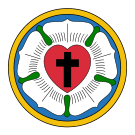
Chief Articles of Faith
in the
Augsburg ConfessionI. God · II. Original Sin · III. The Son of God · IV. Justification By Faith · V. The Office of Preaching · VI. Of The New Obedience · VII. Of The Church · VIII. What the Church Is · IX. Of Baptism · X. Of the Lord's Supper · XI. Of Confession · XII. Of Repentance · XIII. Of the Use of the Sacraments · XIV. · XV. Ecclesiastical Usages · XVI. Of Civil Affairs · XVII. Of Christ's Return to Judgment · XVIII. Of Free Will · XIX. Of the Cause of Sin · XX. Of Good Works · XXI. Of the Worship of the SaintsPractices Movements Gnesio-Lutherans · Crypto-Calvinism · Philippists · Sacramentarians · Ubiquitarians · Lutheran Orthodoxy · Pietism · Laestadianism · Old Lutherans · Neo-Lutheranism · High Church Lutheranism · Evangelical Catholicism · Confessional LutheransEarly Lutheran Controversies Name of controversy
Article of FoC resolving itPersons, parties, documents, and topics pertaining to the controversyAdiaphoristic (1548–55) | X. Majoristic (1551–62) | VI. Georg Major · Justus Menius · Nicolaus von Amsdorf · Nicolaus Gallus · Philippists · Gnesio-LutheransSynergistic (1555–60) | II. Philipp Melanchthon · Johann Pfeffinger · Victorinus Strigel · Matthias Flacius · Philippists · Gnesio-Lutherans · On the Bondage of the WillFlacian (1560–75) | I. Osiandrian-Stancarian (1549–66) | III. Andreas Osiander · Johann Funck · Franciscus Stancarus · Philipp Melanchthon · Matthias Flacius · Andreas Musculus · Victorinus StrigelAntinomian (1527–56) | V. · VI. Crypto-Calvinist (1560–75) | VII. Philipp Melanchthon · Augsburg Confession Variata · Albert Rizaeus Hardenberg · Joachim Westphal (of Hamburg) · Martin Chemnitz · Maximilian Mörlin · Philippists · Sacramentarians · Ubiquitarians · Gnesio-Lutherans · The Sacrament of the Body and Blood of ChristDescent into Hell (15??–53) | IX. Predestination (1561–63) | XI. Lutheran history Start of the
ReformationEventsPosting of The Ninety-Five Theses · Heidelberg Disputation · Leipzig Debate · Marburg Colloquy · Diet of Speyer 1529 · Protestation at Speyer · Presentation of the Augsburg Confession · Reformation in Denmark-Norway and Holstein · Reformation in Finland · Reformation in Germany · Reformation in Iceland · Reformation in Sweden
ReformersMartin Luther · Katharina Luther · Philipp Melanchthon · Johannes Bugenhagen · Johannes Brenz · Justus Jonas · Argula von Grumbach · Petrus Särkilahti · Mikael Agricola · Stephan Agricola · Nicolaus von Amsdorf · Laurentius Andreae · Olaus Petri · Laurentius Petri · Stephan Praetorius · Johann Pfeffinger · Frederick the WiseEarly turmoil EventsDissemination of the Augsburg Confession Variata · Diet of Regensburg · Schmalkaldic War · Augsburg Interim · Peace of Passau · Peace of Augsburg · Colloquy of Worms · Publication of the Magdeburg Centuries · Adiaphoristic Controversy · Second Adiaphoristic Controversy · Controversy on the Descent into Hell · Crypto-Calvinist Controversy · Presentation of the Greek Augsburg Confession · Signing of the Formula of ConcordPeoplePhilipp Melanchthon · Matthias Flacius · Nicolaus Gallus · Cyriacus Spangenberg · Joachim Westphal · Andreas Musculus · Victorinus Strigel · Johannes Agricola · Andreas Osiander · John the MagnanimousFactionsOrthodox
and
Scholastic
periodsEarly OrthodoxyAcceptance of the Book of Concord · Martin Chemnitz · Colloquy of Mumpelgart · Jakob Andreae · Nikolaus Selnecker · David Chytraeus · Mathias Haffenreffer · Leonhard Hutter · Aegidius Hunnius · Stephan PraetoriusHigh OrthodoxyJohann Gerhard · J.A. Quenstedt · Abraham Calovius · Georgius Calixtus · Nicolaus Hunnius · Jesper Brochmand · Salomo Glassius · Johann Hülsemann · J.C. Dannhauer · J.F. König · Johannes Musaeus · J.W. Baier · Thirty Years' WarLate OrthodoxyRevivals J.G. Hamann · Hans Nielsen Hauge · Haugeanism · Paavo Ruotsalainen · Finnish Awakening · Claus Harms · Lars Levi Læstadius · Laestadianism · Carl Olof Rosenius · N.F.S. Grundtvig · Friedrich TholuckRepristination SchoolErlangen schoolG.C.A. von Harless · J.W.F. Höfling · Gottfried Thomasius · J.C.K. von Hofmann · Franz Delitzsch · K.F.A. Kahnis · Theodosius Harnack · C.E. Luthardt · F.H.R. von Frank · Paul Althaus · Werner ElertGermanySchism of the Old Lutherans · Background · J.G. Scheibel · Eduard Huschke · Henrik Steffens · H.E.F. Guericke · G.P.E. Huschke · Free churchesAustralia and New GuineaUnited States of AmericaMartin Stephan · J.A.A. Grabau · Wilhelm Sihler · F.C.D. Wyneken · C. F. W. Walther · H.A. Preus · Synodical Conference of North AmericaPresentOrder of the Divine Service in Lutheranism Preparatory Service Entrance hymn and Trinitarian formula (known as the Invocation) · Penitential Rite including the Confiteor and Declaration of Grace (or Asperges on Easter)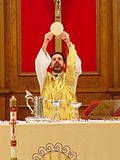
The Service of the Word Introit · Gloria Patri · Kýrie · Gloria · Dominus Vobiscum · Oremus · Collect · Old Testament reading · gradual (or Responsorial Psalm) · Epistle · Alleluia (tract during Lent) · Gospel · Hymn of the day · Homily or Postil (Sermon) · Nicene Creed (Athanasian Creed on Trinity Sunday) · Offertory · Prayers of the FaithfulThe Service of the Eucharist Preface (Sursum corda / Sanctus / Hosanna) · Eucharistic Prayer (Epiclesis / Words of Institution / Memorial Acclamation) · Lord's Prayer · Sign of peace / pax (elevation) · Agnus Dei · Distribution · Nunc dimittis · Postcommunion · Benedicamus Domino · Benediction · Dismissal · Ite missa estParticipants Parts of the Sanctuary altar · altar bell · altar crucifix · altar rails · kneeler · piscina · processional cross · tabernacleCandles Liturgical vessels Liturgical objects collection basket · holy water · incense (use) · paten · sacramental bread (wafer) · sacramental wine · thuribleVestments Liturgical books and hymnals Agenda · Evangelical Lutheran Hymn-Book · Evangelical Lutheran Worship · Lutheran Book of Worship · Lutheran Hymnal · Lutheran Hymnal with Supplement · Lutheran Service Book · Lutheran Worship · Service Book and HymnalLutheran Hymnody Hymns A Mighty Fortress Is Our God • Aus tiefer Not schrei ich zu dir • Christ Lay in Death's Bonds • Es ist das Heil uns kommen her • Gelobet seist du, Jesu Christ • God's Word Is Our Great Heritage • How Lovely Shines the Morning Star • In Thee alone, O Christ, my Lord • Jesus Loves Me • Lo, How a Rose E'er Blooming • Nun bitten wir den Heiligen Geist • Now come, Saviour of the gentiles • Now Thank We All Our God • O Lord, Look Down from Heaven • O Dearest Jesus, What Law Hast Thou Broken • O Sacred Head, Now Wounded • Passion Hymns • Wake, Awake, for Night is Flying •
Was willst du dich betrüben
Hymnals Topics People Johann Sebastian Bach • Dieterich Buxtehude • Johann Crüger • Simon Dach • Claus Harms • Paul Gerhardt • Nikolaj Frederik Severin Grundtvig • Johann Heermann • Martin Luther • Felix Mendelssohn • Philipp Nicolai • Johann Pachelbel • Hallgrímur Pétursson • Michael Praetorius • Sigfrid Karg-Elert • Martin Rinkart • Johann von Rist • Carl Schalk • Paul Speratus • N. Samuel of Tranquebar • Jaroslav Vajda • Johann Walter • Catherine Winkworth • Johannes ZahnPart of a series on Christianity Jesus Christ 
Foundations Bible Theology Apologetics · Baptism · Christology · God · Father · Son · Holy Spirit · History of theology · Mary · Salvation · TrinityHistory and
traditionChurch Fathers · Early Christianity · Constantine · Ecumenical councils · Creeds ·
Missions · East–West Schism · Crusades · Protestant Reformation · ProtestantismDenominations
(List) and
MovementsWestern: Adventist · Anabaptist · Anglican · Baptist · Calvinism · Evangelical · Holiness ·
Independent Catholic · Lutheran · Methodist · Old Catholic · Pentecostal · Quaker · Roman Catholic
Eastern: Eastern Orthodox · Eastern Catholic · Oriental Orthodox (Miaphysite) · Assyrian
Nontrinitarian: Christadelphian · Jehovah's Witness · Latter Day Saint · Oneness Pentecostal · UnitarianTopics Art · Criticism · Ecumenism · Liturgical year · Liturgy · Music · Other religions · Prayer · Sermons · SymbolismCategories:- Lutheranism
- Martin Luther
- Protestant Reformation
- Protestantism
- Chalcedonianism
- Christian terms
Wikimedia Foundation. 2010.

